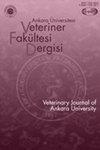土耳其奶牛群跛足造成的经济损失和可避免的损失
IF 0.9
4区 农林科学
Q3 VETERINARY SCIENCES
引用次数: 0
摘要
本研究旨在估计与土耳其奶牛群跛足有关的总财务(直接和间接)和可避免的损失。使用官方和以前发表的数据来确定平均值(12.9%)和目标患病率(6.6%)值。跛足造成的直接经济损失计算为治疗费用、非自愿扑杀和产奶量损失。间接损失包括产犊间隔延长和额外的授精损失。因此,奶牛养殖场每例跛行造成的平均经济损失为153.8美元(轻度跛行116.8美元,重度跛行264.7美元)。计算出可避免的损失(75.1美元),相当于在本文章由计算机程序翻译,如有差异,请以英文原文为准。
Total financial and avoidable losses due to lameness in Turkish dairy herds
This study aimed to estimate the total financial (direct and indirect) and avoidable losses related to lameness in Turkish dairy herds. Official and previous published data were used for determining the mean (12.9%) and target prevalence (6.6%) values. Direct financial losses due to lameness were calculated as treatment costs, involuntary culling, and milk yield losses. Indirect losses consisted of extended calving intervals and extra insemination losses. As a result, an average financial losses of lameness per case on dairy farms was $153.8 ($116.8 for mild and $264.7 for severe forms). Avoidable losses were calculated ($75.1), equalling 187 Lt. of cow milk in Türkiye conditions. The share of direct and indirect financial losses was 49.6% and 50.4%, respectively. Total annual losses related to lameness in Türkiye are calculated as $130.5 million (326 million Lt. milk eq.); however, $63.7 million (=159 million Lt. milk eq.) of the losses could be avoided by farmers. Milk equivalent of avoidable losses equates to 0.77% of the total milk production of Türkiye annually. In conclusion, lameness causes significant financial losses in Turkish dairy herds. However, almost half of these losses (48.8%) may be avoidable with a better management practices, thus increasing the productivity and profitability of dairy farmers.
求助全文
通过发布文献求助,成功后即可免费获取论文全文。
去求助
来源期刊
CiteScore
1.50
自引率
0.00%
发文量
44
审稿时长
6-12 weeks
期刊介绍:
Ankara Üniversitesi Veteriner Fakültesi Dergisi is one of the journals’ of Ankara University, which is the first well-established university in the Republic of Turkey. Research articles, short communications, case reports, letter to editor and invited review articles are published on all aspects of veterinary medicine and animal science. The journal is published on a quarterly since 1954 and indexing in Science Citation Index-Expanded (SCI-Exp) since April 2007.

 求助内容:
求助内容: 应助结果提醒方式:
应助结果提醒方式:


